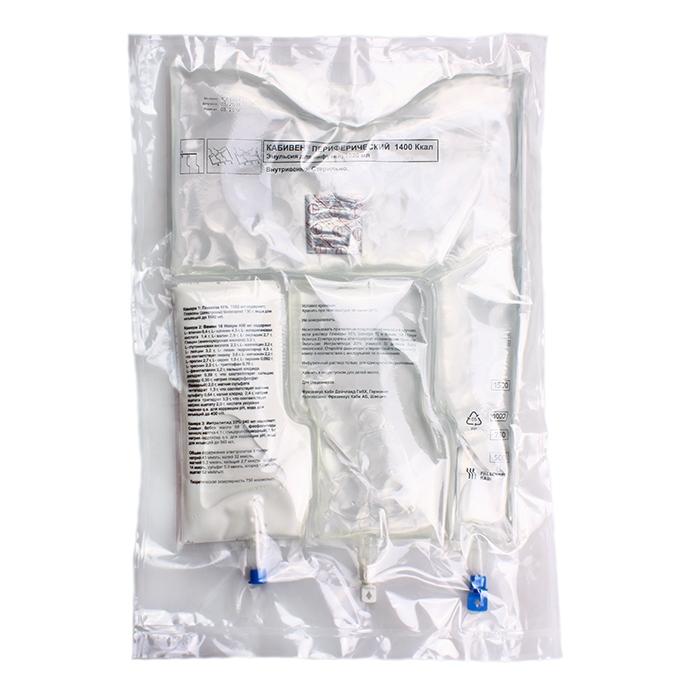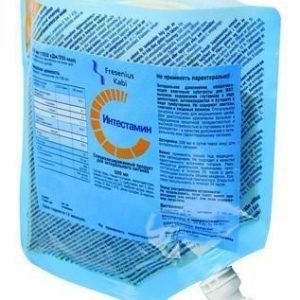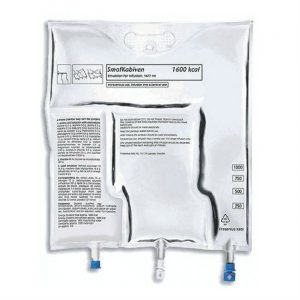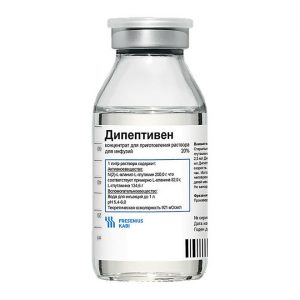Description
Latin name
Kabiven
Release form
An emulsion for infusion, formed after mixing the contents of the three chambers of a three-chamber bag, homogeneous, white.
packaging 4 pcs. of 1920 ml
Indications
Parenteral nutrition for adults and children 2 years of age and older, when oral or enteral nutrition is impossible, insufficient or contraindicated.
Contraindications
known hypersensitivity to egg or soy proteins or any auxiliary component of the drug
severe hyperlipidemia
severe hepatic insufficiency
severe blood clotting
congenital metabolic disorders lack of acute leukemia requiring insulin administration in an amount of more than 6 PIECES / h
pathologically increased plasma concentration of any of the
electrolytes included in the preparation general contraindications for infusion therapy: acute pulmonary edema, hyperhydration, decompensated heart failure, hypotonic dehydration
unstable conditions (for example, post-traumatic , uncompensated diabetes mellitus, acute myocardial infarction, decompensated metabolic acidosis, severe sepsis and hyperosmolar coma).
Caution: impaired lipid metabolism due to kidney failure, diabetes mellitus, pancreatitis, impaired liver function, hypothyroidism (with hypertriglyceridemia), or sepsis. With the introduction of the drug Kabiven ® to the central patient with such disorders, careful monitoring of the concentration of triglycerides in the blood plasma is necessary. Kabiven ® Central is intended primarily for patients older than 2 years. In children under 2 years of age, Kabiven ® Central can be used only for health reasons in the absence of special adapted amino acid solutions containing taurine (Aminoven infant). Premature infants and low birth weight babies may have impaired fat metabolism. Carefully monitor triglyceride levels.
Composition
Active substances: glucose 11% – 1180 ml vamin 18 Novum – 400 ml intralipid 20% – 340 ml.
Dosage and administration
The drug is administered intravenously.
Kabivena peripheral has an osmolarity of 750 mOsm / l, and therefore the drug can be administered to adults and children in peripheral or central veins.
The infusion can be continued as long as the clinical condition of the patient requires, based on the daily requirement for glucose, lipids and amino acids. The dose of the drug and the rate of infusion are determined by the patient s ability to excrete lipids and metabolize glucose.
Cabiven peripheral is available in three sizes of bags designed for patients with normal, moderately elevated or reduced nutrient requirements. Complete parenteral nutrition may require the addition of vitamins, electrolytes, and trace elements.
The dose should be selected individually, and when choosing the volume of the bag should take into account the patient’s condition, body weight and need for nutrients.
In obese patients, the dose should be set based on ideal body weight.
In patients with moderate or severe catabolic stress with or without malnutrition, the need for amino acids is 1-2 g / kg / day, which roughly corresponds to the need for nitrogen 0.15-0.3 g / kg / day. The energy requirement is 30-50 kcal / kg / day. This corresponds to 40 ml / kg / day.
In patients without catabolic stress, the need for amino acids is 0.7-1 g / kg / day, which is approximately equal to the need for nitrogen 0.1-0.15 g / kg / day. The energy requirement is 20-30 kcal / kg / day. This corresponds to 27-40 ml of peripheral Kabiven per 1 kg of body weight per day.
Side effects
Allergic reactions: anaphylactic reaction, fever, chills, trembling, skin rash, urticaria.
From the respiratory system: changes in respiration (tachypnea).
From the cardiovascular system: decrease or increase in blood pressure.
From the digestive system: increased activity of liver enzymes, abdominal pain.
From the hemopoietic system: hemolysis, reticulocytosis.
Local reactions: thrombophlebitis by infusion into peripheral veins.
Other: headache, priapism.
When administered correctly, side effects are extremely rare.
Drug Interactions
At therapeutic doses, heparin causes a transient release of lipoprotein lipase into the bloodstream, which may lead initially to increased lipolysis in blood plasma, and then to a transient decrease in TG clearance.
Insulin can also affect lipase activity, but there is no evidence of its adverse effect on the therapeutic efficacy of the drug.
Vitamin K1 contained in soybean oil is an antagonist of coumarin derivatives, therefore, it is recommended to carefully monitor blood coagulation in patients receiving these drugs.
Kabiven peripheral can be mixed only with those medicines and nutrient solutions for which compatibility with it is confirmed, for example: Vitalipid N adult and Vitalipid N children’s Soluvit N Addamel N Dipeptiven. Mixing solutions should be carried out under aseptic conditions.
Overdose
Symptoms: due to impaired ability to remove fat, fatty syndrome may develop – hyperlipidemia, fever, hepatosplenomegaly, anemia, leukopenia, thrombocytopenia, coagulopathy and coma.
Treatment: discontinuation of lipid infusion, symptomatic therapy.
Storage Conditions
The product should be stored out of the reach of children at a temperature not exceeding 25 ° C.
Expiration
2 years.
active substance
amino acids for parenteral nutrition
lekarstvennaja form
Ñmulsyya for infusions
Fresenius Kabi, Germany




